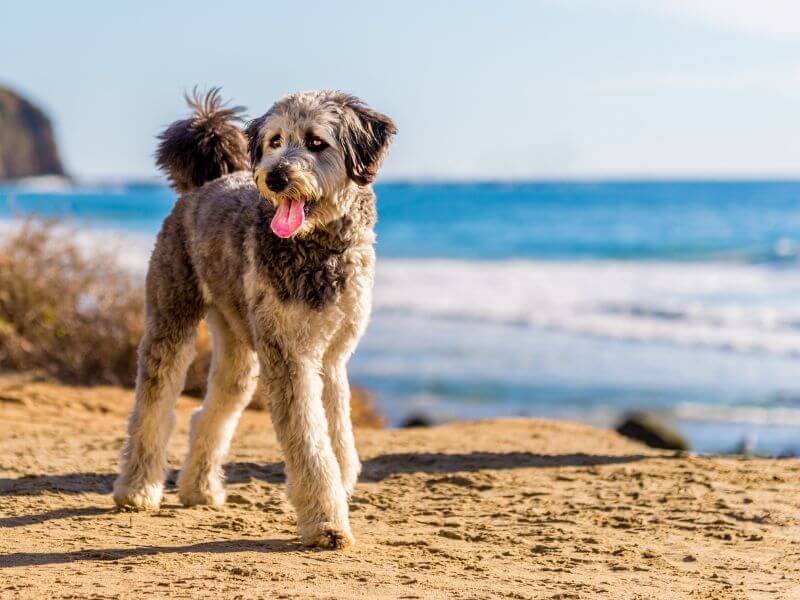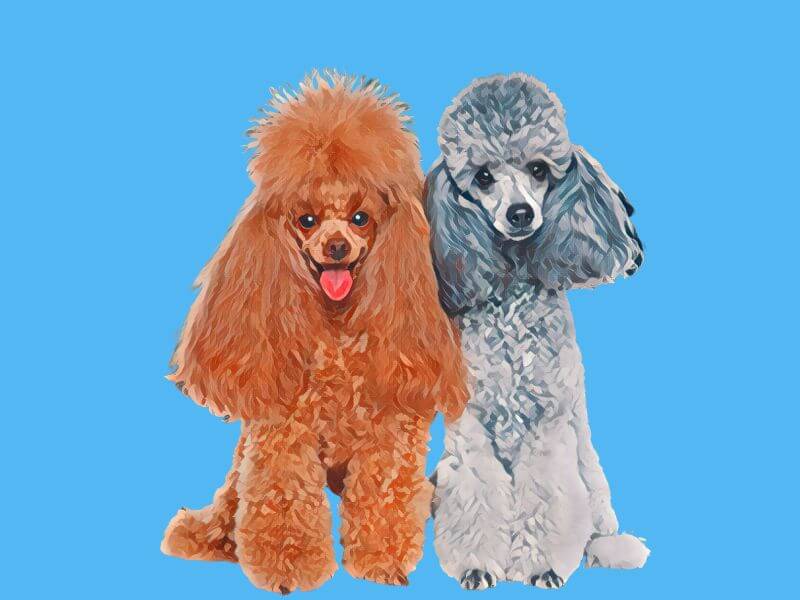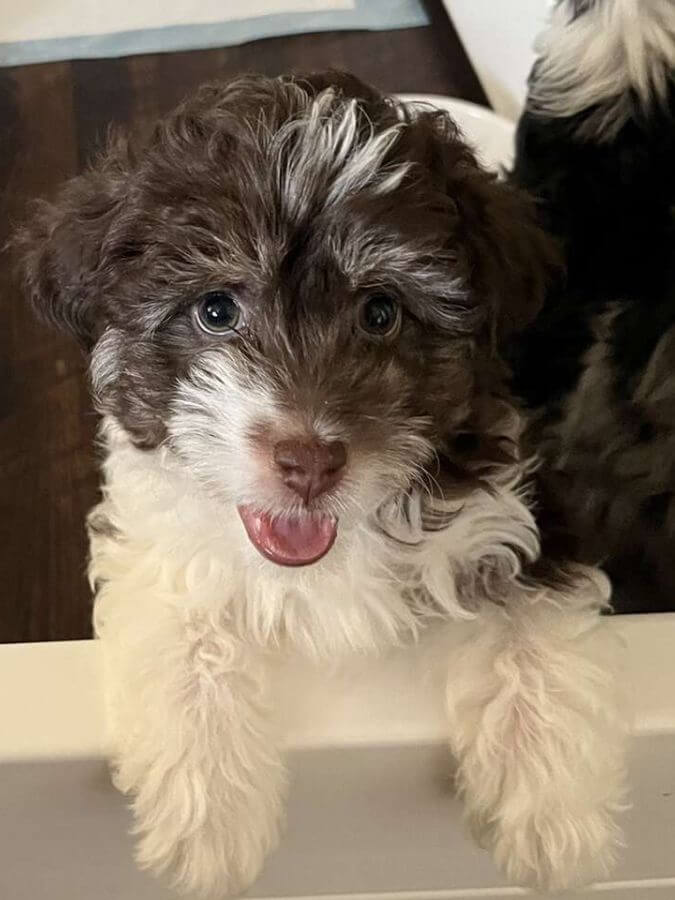A Toy Aussiedoodle is the smallest type of Aussiedoodle, which is a mix between a Poodle and an Australian Shepherd.
Toy dogs have become popular recently due to their tiny-size and ridiculous cuteness. Doodle dogs have especially have seen a rise in demand due to their excellent personalities and hypoallergenic coats.
So, is the Toy Aussiedoodle going to be the next addition to your household?
Check out this sassy bundle of fur in this article!
What is a Toy Aussiedoodle?
The Toy Aussiedoodle is a mix of a Toy Poodle and an Australian Shepard. They are smaller versions of a standard Aussiedoodle, a cross between a standard Poodle and an Australian Shepherd. They can also be referred to as Toy Aussiepoo.
There are a few ways in which Toy Aussiedoodles are bred. One method is artificial insemination between a Toy Poodle and an Australian Shepherd.
Another method is the deliberate breeding down in size between a Poodle and an Australian Shepherd. The breeder would pick smaller dogs from the litter to use in a future litter to create a smaller mix. Or, the breeder can introduce a smaller dog breed, such as a Chihuahua, to make the litter smaller.
A smaller-sized Australian Shepherd, such as a Miniature Australian Shepherd, can also be used. A Mini Australian Shepherd paired with a Toy Poodle could be a way to breed Toy Aussiedoodles.
The method the breeder uses will affect the generation of the Toy Aussiedoodle. For example, a purebred Toy Poodle and a purebred Australian Shepherd would create an f1 Toy Aussiedoodle.
If the litter is selectively bred down in size or another breed is introduced, it could fall into the second or third generation, such as an f2 Toy Aussiedoodle. Aussiedoodle generations are something to note when searching for a prospective breeder.
Popularity of the Toy Aussiedoodle
Since the inception of the Aussiedoodle, the breed has gained popularity worldwide.
Google search data shows Aussiedoodles are in the top 10 most searched Doodle breeds. There are over 970,000 posts about Aussiedoodles on Instagram!
Toy Aussiedoodles are a relatively new type of mix. Miniature and Toy Doodles are becoming increasingly popular due to their size. They are easy to maintain and do not require a lot of living space (or food!) like a bigger Doodle dog.
Their short legs require less exercise than a standard-sized dog. They can be picked up and carried around all over the place. This, along with an excellent personality, makes the Toy Aussiedoodle a popular choice for many.
In general, Aussiedoodles embody the epitome of the ultimate family dog. The two parent breeds pass down personality traits that make these dogs easy to train, goofy, and affectionate to all family members.
Origins of the Toy Aussiedoodle
Toy Aussiedoodles, and Aussiedoodles in general, are a relatively new designer breed. There is not much documentation on when the breeds were mixed.

The first bit of records suggests that breeders started mixing the two in the late 1990s-2000s [1]Dog Time. Even then, it is hard to determine how authentic the sources are. With some confidence, I can say the Toy Aussiedoodle has been around for less than 30 years.
Despite not much being known about the development of the Toy Aussiedoodle breed, there is a great deal of information about its parent breeds: the Australian Shepard and Poodle. Diving into the origins of a hybrid’s lineage can help give us insight into the behavioral traits and characteristics the mixed breed might have.
We’ll start by looking at the Australian Shepard.
Australian Shepherd

Australian Shepherds come from the Pyrenees mountains between Spain and France. They were used as herding dogs in that region. After some time, they were brought over to New Zealand and Australia.
It is believed they may have been crossed with other Australian-native dogs. In the mid-1800s, they were introduced to the western regions of the United States to be used mainly as sheepherding dogs.
They are hard-wired to herd. They are medium-sized with an athletic build. Their desire to herd, or to have a job, is so strong that they will herd young children and even their chew toys.
Australian Shepherds are not for every household. They require mental stimulation and extensive exercise. These traits are tamed down a bit when mixed with the Poodle, which is why Aussiedoodles have become a popular mix.
Toy Poodle

Poodles have a rich history that dates back more than 400 years ago [2]www.akc.org/dog-breeds/poodle-miniature.
Many people associated Poodles with France. However, these beautiful dogs originated in Germany. The name “Poodle” comes from “pudel,” a German word that means “to splash in” in English.
They were bred to be water-fowl hunters and retrievers. This enabled them to evolve as strong, athletic, and intelligent dogs. They are eager to learn and perform specific duties, which means they respond well to training.
Poodles slowly migrated from the hunting fields to people’s homes. Many Europeans, especially the French, took a liking to Poodles, and the breed began to spread across the continent.
Poodles remained hunting companions but were dispersed into other areas, such as the circus and French nobles’ sides.
Eventually, the standard-size Poodle was bred down to create the Miniature Poodle. Mini is now the most popular Poodle size [3]vcahospitals.com/know-your-pet/dog-breeds/miniature-poodle.
In America, the Mini Poodle was bred down even more to create the Toy Poodle. The breed was selectively bred to produce a smaller dog for easy transportation and handling. It is also suggested that the Toy Poodle was created for city dwellers.
Their tiny size made them excellent companions for people living in the small, cramped apartments often seen in big cities.
The Toy Poodle is the smallest size of Poodle and only grows up to 10 inches and weighs between 4 and 6 pounds [4]www.akc.org/dog-breeds/poodle-toy
This small but sassy pup is an excellent choice for designer mixes. The Toy Aussiedoodle benefits significantly from its Toy Poodle parent’s traits and characteristics.
Appearance of the Toy Aussiedoodle
So what does a Toy Aussiedoodle look like? Half Australian Shepard, half Poodle? Well, it depends.
Toy Aussiedoodles vary in appearance depending on which traits they inherit from their parents. Because the Toy Aussiedoodle is a mixed breed, it can inherit characteristics close to that of the Australian Shepard, the Poodle, or be an even mix of the two.
So, for this reason, it is pretty tricky to pindown set appearance traits of the Toy Aussiedoodle because, quite frankly, it can differ from pup to pup. For instance, some Toy Aussiedoodles inherit tighter curls in their coat closer to their Poodle parent, while others have wavy coats.
The length of the Toy Aussiedoodles coat is typically medium-length.
Coat Colors
The Poodle has a lot of different possible coat colors. These colors include blue, black, red, brown, chocolate, cream, gray, white, and a few others.
Mostly, Toy Aussiedoodles seem to inherit the Australian Shepard’s “hue” of colors. These colors include red merle, blue merle, black and red trim, parti and sable, and tan colors.
Coat Patterns
It is important to note that merle is a type of coat pattern.
Australian Shepherds are one of the few dog breeds in which merle patterns are in their genes. For this reason, the Toy Aussiedoodle has a higher chance of being a merle (red merle, blue merle, or sable merle).
Below are the few different types of coat patterns a Toy Aussiedoodle might have:
- Merle
- Phantom
- Tuxedo
- Solid color (mono-color)
- Parti
- Tricolor
- Two colors (e.g., black and white, black and tan, etc.)
Toy Aussiedoodle Size
Toy Aussiedoodles are small, hence their name. Since they are a relatively new spin to the Aussiedoodle, there is no factual data on their size.
It is estimated that they will weigh between 4-20 pounds. Like most Toy breeds, they shouldn’t stand any taller than 10 inches.
You should use the parents’ size as a guideline for estimating the size of your Toy Aussiedoodle. Ask your breeder, especially if they have had previous litters.
Other Aussiedoodle Sizes
If you want a larger-sized Aussiedoodle, you should look for a Miniature Aussiedoodle or a standard Aussiedoodle.
Mini Aussiedoodles generally weigh more than 20 pounds.
Standard Aussiedoodles are the largest of the group and usually weigh more than 40 pounds.
Eye Color
Toy Aussiedoodles can have a wide range of eye colors. The eyes can be striking blue, soft green, light amber, or deep brown.
Toy Aussiedoodles may inherit heterochromia.
This is a condition that produces two different eye colors. For instance, your Toy Aussiedoodle might have one striking blue eye and the other a deep brown eye. Your Toy Aussiedoodle may also have an unusually colored coat if he has two different eye colors.
There may be spots or streaks of white in their coats. This differs from a standard coat appearance due to the close connection of genes between eye color and coat color [5]Inverse.
Temperament
The Toy Aussiedoodle is one of those dogs that embodies the stereotype of a playful and energetic canine. Often described as goofy and fun-loving, these dogs are a ball of positive energy. And – speaking of power – Toy Aussiedoodles have lots of it (despite their size).
You would be hard-pressed to find these dogs lounging around the house the whole day. These are active dogs that need to expend their energy. Going for walks, playing fetch, or running with your dog will help keep them happy (and it will also be good for your heart).
Also, you may discover an unexpected personality trait in the Toy Aussiedoodle that derives from one of its parent breeds. For example, thanks to the Poodle parent, you may find that your Toy Aussiedoodle enjoys the water.
Or you may find that your Toy Aussiedoodle tends to herd you and your children, thanks to the herding nature of the Australian Shepard. If you see this happening, know that it is not an act of aggression and should not be dealt with.
Nonetheless, one thing is sure: the Toy Aussiedoodle is highly intelligent.
As a result, training should be much easier compared to other breeds. Begin training and socializing your Toy Aussiedoodle puppy early. When training, the best method is to use positive reinforcement (rewards, praise, or treats) when the desired behavior is performed.
It should be noted that Toy Aussiedoodle can become easily bored. Therefore, it is essential to keep your dog physically and mentally challenged. If your Toy Aussiedoodle feels bored, it may result in destructive behavior.
Consider teaching your dog new tricks, giving them puzzles, or rotating out old toys for new ones to help keep them mentally stimulated. Toy Aussiedoodles are also very loyal and can form a close attachment to one or two of their favorite humans and remain very close to them.
This doesn’t mean that they don’t like other people, however. Toy Aussiedoodles are friendly to all people if adequately socialized. It just means that you are lucky enough to be “chosen” by your Toy Aussiedoodle to be their best friend.
Traits & Characteristics
Below is a summary of the various traits and characteristics the Toy Aussiedoodle has.

Health
Toy Aussiedoodles may be susceptible to health problems common to their parent breeds – the Australian Shepard and the Poodle.
Hip dysplasia, cataracts, progressive retinal atrophy, epilepsy, autoimmune thyroiditis, and sebaceous adenitis are some of the health issues your Toy Aussiedoodle may be susceptible to.
If you are purchasing your Toy Aussiedoodle from a breeder, you should ask them to provide proof that the parent breeds (and their lineage) have been screened for common defects and deemed healthy to breed.
Having the dog’s parents checked by the vet is not sufficient.
Suppose a breeder says a veterinarian has “checked” the dogs or that no health tests are necessary because the dogs have never had any problems before; In that case, it is best to go to a reputable breeder who is more rigorous about testing.
A breeder should only breed healthy dogs, so testing should be done to verify the dogs’ health.
Unfortunately, not all of us can see proof of our dogs’ health, especially if we didn’t purchase them from a breeder but a shelter. Therefore, it is essential to go for regular checkups at the vet, so the veterinarian can keep an eye out for any common ailments and treat them if necessary.
Are Toy Aussiedoodles ethical?
The question of Toy breeds has been looming in the dog world for ages. Toy breeds sometimes get a bad rap, which is often justified.
As humans, we love tiny things. Small things to us are cute and cuddly. This is why we love puppies; they are like miniature, baby versions of an adult dog. So why not just create a small dog that will always be the size of a puppy?
This is likely where the Toy dog breeds got their start. It is not unethical to want a small dog you can carry around with you everywhere. Ethics come into play when breeders start pushing the limit to get smaller and smaller dogs.

Toy breeds, such as the Toy Aussiedoodle, can be produced by deliberately breeding the most miniature dogs of each litter. This, in essence, creates a smaller dog. The problem is that this type of breeding often leads to incest which can lead to puppies having poor health.
Plus, the smaller the dog gets, the harder it is to treat them medically. I read an article in which a veterinarian explains that teacup or micro-sized dogs cannot receive the same medical attention as standard-sized dogs. How can you put an IV in a dog that’s not much bigger than the size of the needle?
A good breeder will genetically test the parents to ensure they are healthy to breed. A breeder looking to produce the smallest dog possible will not care about health testing. This creates a chain reaction that could lead to very unhealthy litter.
The Australian Shepherd is a small-to-medium-sized dog. Toy Poodles are tiny. The two can breed to create a Toy Aussiedoodle.
Knowing this information, you better find a trustworthy breeder for your Toy Aussiedoodle.
Finding a reputable breeder
Since Toy Aussiedoodles are all the rage, finding one to join your forever family should not be too difficult. As I covered in the last section, ensure that the breeder you choose is reputable.
Although you won’t get any pedigree papers for the Toy Aussiedoodle, you should be able to view the pedigree papers for the parent’s lineage and temperament in person.
However, while their temperant is a significant factor in their popularity, they have an even bigger selling point – their cuteness. Toy Aussiedoodles are incredibly cute, especially as puppies. And cuteness sells.
While nothing is wrong with the ‘cuteness’ factor, many breeders jump at the chance to profit from the Toy Aussiedoodle’s popularity. Unfortunately, the Doodle world has been plagued by bad actors looking to make a buck.
Before you settle on a breeder, make sure you contact them and set up a visit. Request that you would like to see the parents and assess their living conditions. You should also contact other Toy Aussiedoodle owners for their reviews and opinions.
How much does a Toy Aussiedoodle cost?
Although the Toy Aussiedoodle is a wildly popular dog, it does not mean they are cheap. For most, the price of an Aussidoodle is on the steep end of the scale, especially if you purchase the Toy Aussiedoodle from a breeder.
When purchasing from a breeder, Toy Aussiedoodle puppies can go anywhere from $500-$5000.
If you wonder why they can go for such high prices, Toy Aussiedoodles are designer dogs. The price will increase even more if the dog has a unique coat color or pattern. Merle Toy Aussiedoodles and tricolor Toy Aussiedoodless will be sold at a premium.
However, ensure you obtain proof of parental lineage from the breeders before paying these prices. It is no good putting all that money into the pockets of a puppy mill.
Other factors such as the breeder’s location and reputation, litter size, training, socialization efforts, generation, and health tests can all affect the cost of a Toy Aussiedoodle.
Do Toy Aussiedoodles bark a lot?
Toy Aussiedoodles are not big on barking (thank goodness). This does not mean, however, that they won’t bark if necessary. Like many other dogs, the Toy Aussiedoodle may bark to get your attention or for territorial reasons.
For instance, your Toy Aussiedoodle may be fine meeting new strangers but may bark at other dogs passing by.
Are Toy Aussiedoodles hypoallergenic?
A dog can’t be completely hypoallergenic. Dander and stray hairs are a product of any pup. However, Toy Aussiedoodles have a relatively hypoallergenic coat. The Poodle is known for its low-dander coat, while the Australian Shepherd is known for needing frequent grooming.
Final Thoughts
The Toy Aussiedoodle is a cute little dood. They may be small but they are full of energy and love for their family. Perfect with young children, smart as a whip, and tiny enough to take anywhere – you better start calling breeders right now!


